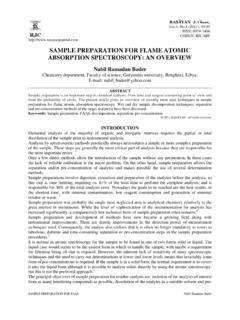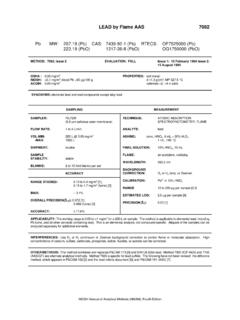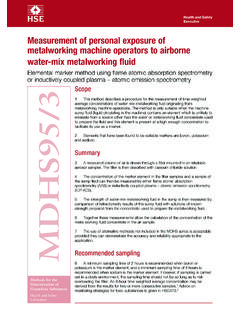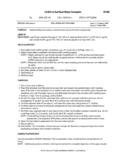Transcription of SODIUM CARBOXYMETHYL CELLULOSE - Food and …
1 SODIUM CARBOXYMETHYL CELLULOSE Prepared at the 28th JECFA (1984), published in FNP 31/2 (1984) and in FNP 52 (1992). Metals and arsenic specifications revised at the 55th JECFA (2000). An ADI not specified was established for modified celluloses at the 35th JECFA (1989). SYNONYMS SODIUM CELLULOSE glycolate, Na CMC, CMC, CELLULOSE gum, SODIUM CMC; INS No. 466 DEFINITION Prepared from CELLULOSE by treatment with alkali and monochloro-acetic acid or its SODIUM salt. The article of commerce can be specified further by viscosity.
2 Chemical names SODIUM salt of CARBOXYMETHYL ether of CELLULOSE number 9004-32-4 Chemical formula [C6H7O2(OH)x(OCH2 COONa)y]n where n is the degree of polymerization x = to y = to x + y = (y = degree of substitution) Structural formula where R = H or CH2 COONa Formula weight Structural unit with a degree of substitution of : Structural unit with a degree of substitution of : Macromolecules: greater than about 17,000 (n about 100) Assay Not less than of SODIUM CARBOXYMETHYL CELLULOSE , calculated on the dried basis DESCRIPTION White or slightly yellowish, almost odourless hygroscopic granules, powder or fine fibres FUNCTIONAL USES Thickening agent, stabilizer, suspending agent CHARACTERISTICS IDENTIFICATION Solubility (Vol.)
3 4) Yield viscous colloidal solution with water; insoluble in ethanol Foam test Vigorously shake a solution of the sample. No layer of foam appears. This test distinguishes SODIUM CARBOXYMETHYL CELLULOSE from other CELLULOSE ethers and from alginates and natural gums. Precipitate formation To 5 ml of an solution of the sample add 5 ml of a 5% solution of copper sulfate or of aluminium sulfate. A precipitate appears. (This test permits the distinction of SODIUM CARBOXYMETHYL CELLULOSE from other CELLULOSE ethers, and from gelatine, carob bean gum and tragacanth gum).
4 Colour reaction Add g of powdered carboxymethylcellulose SODIUM to 50 ml of water, while stirring to produce a uniform dispersion. Continue the stirring until a clear solution is produced. To 1 ml of the solution, diluted with an equal volume of water, in a small test tube, add 5 drops of 1-naphthol TS. Incline the test tube, and carefully introduce down the side of the tube 2 ml of sulfuric acid so that it forms a lower layer. A red-purple colour develops at the interface. PURITY Loss on drying (Vol.)
5 4) Not more than 12% after drying (105o, to constant weight) pH (Vol. 4) - (1 in 100 soln) SODIUM (Vol. 4) Not more than on the dried basis Determine total SODIUM content by Atomic Absorption Spectroscopy or flame Photometry SODIUM chloride Not more than on the dried basis See description under TESTS Free glycolate Not more than calculated as SODIUM glycolate on the dried basis See description under TESTS Degree of substitution Not less than and not more than See description under TESTS Lead (Vol.
6 4) Not more than 2 mg/kg Determine using an atomic absorption technique appropriate to the specified level. The selection of sample size and method of sample preparation may be based on the principles of the method described in Volume 4, Instrumental Methods. TESTS PURITY TESTS SODIUM chloride Heat 5 g of the sample, weighed to the nearest mg, in a platinum or porcelain crucible, first with a small flame so that the sample does not ignite and then, when the charring is complete, heat further in an electric oven for 15 min at about 500o.
7 After cooling, pulverize the ashes thus obtained and extract several times with warm water. Filter the extracts into a 500-ml volumetric flask, acidify with nitric acid and dilute to the mark. Determine the NaCl content of 100 ml of this extract by the method of Volhard, using N silver nitrate and N ammonium thiocyanate. Each ml of N silver nitrate is equivalent to mg of NaCl. Calculate the SODIUM chloride content by the formula: where a = ml of N silver nitrate used b = dry weight of 5 g of the sample Free glycolate Weigh g of the sample to the nearest mg, and transfer to a 100-ml beaker.
8 Moisten the sample thoroughly with 5 ml of glacial acetic acid, followed by 5 ml of water, and stir with a glass rod until the solution is complete (usually about 15 min are required). Slowly add 50 ml of acetone while stirring and then approximately 1 g of SODIUM sulfate. Continue the stirring for several min to ensure complete precipitation of the CARBOXYMETHYL CELLULOSE . Filter through a soft, open-texture paper, previously wetted with a small amount of acetone, and collect the filtrate in a 100-ml volumetric flask.
9 Use 30 ml of acetone to facilitate the transfer of the solids and to wash the filter cake. Make up to volume with acetone and mix. Prepare a blank solution containing 5 ml of water, 5 ml of glacial acetic acid and acetone in another 100-ml volumetric flask. Pipet 2 ml of the sample solution and 2 ml of the blank solution into two 25-ml volumetric flasks. Remove the acetone by heating the uncovered flasks upright in a boiling water bath for exactly 20 min. Cool to room temperature and add 5 ml of naphthalenediol TS, mix thoroughly, then add 15 ml more of the TS and mix.
10 Cover the mouth of the flask with a small piece of aluminium foil and heat upright in the boiling water bath for 20 min. Cool to room temperature and make up to volume with naphthalenediol TS. Measure the absorbance of sample solution against blank solution at 540 nm using 1-cm cells. Read the corresponding mg of glycolic acid from the calibration curve obtained as follows: Introduce 0, 1, 2, 3 and 4-ml aliquots of standard glycolic acid solution (1 mg per ml, prepared by weighing accurately g of glycolic acid, previously dried in a vacuum desiccator for at least 16 h, and then dissolving in 100 ml of water; do not keep the solution longer than 30 days) into a series of five 100-ml volumetric flasks.

















